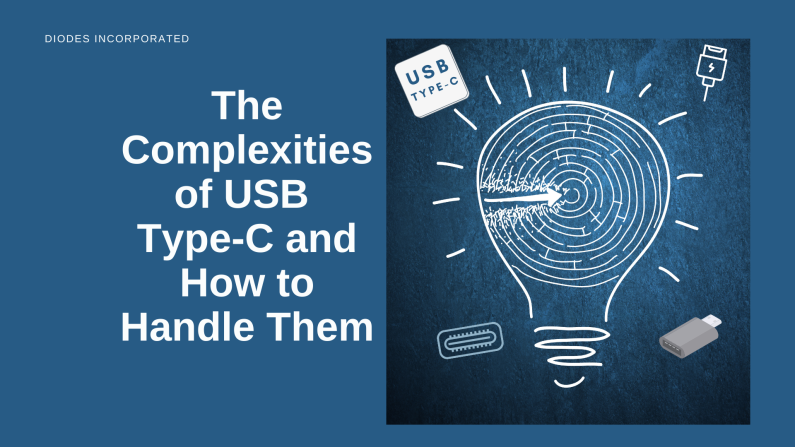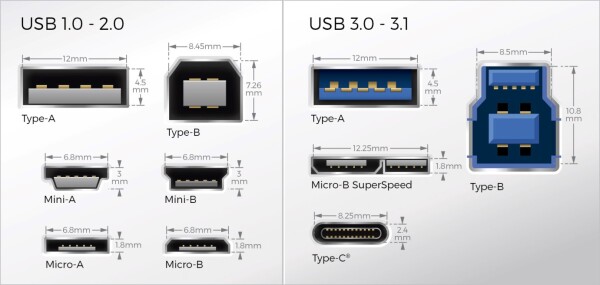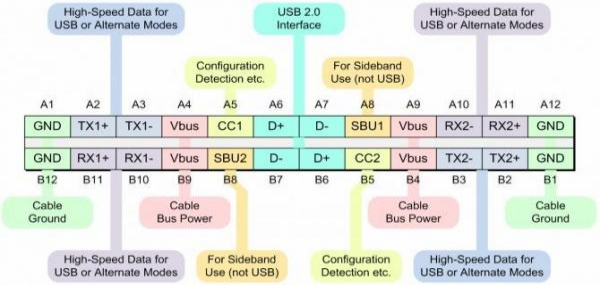The Complexities of USB Type-C and How to Handle Them

By: Muhammad Zafar Kausar, Junior Applications Engineer
USB’s Road to Ubiquity
The universal serial bus emerged in the mid-nineties and has now become a convenient and ubiquitous interconnect that streamlines the growing number and diversity of cables connecting personal computers to peripherals, like printers, scanners, and keyboards. Its arrival greatly simplified setting up home and office computers, and saved laptop users from carrying a multitude of bulky cables to connect peripherals and accessories.
Widespread implementation of USB interfaces began in the late 1990s and early 2000s as the standard evolved to support data-transfer rates of 12.0Mbit/s and 480Mbit/s; retrospectively named FullSpeed and HiSpeed. The USB 2.0 standards allow and still support both these data rates, as well as features not available in USB 1.x that provide extra flexibility for users. Since then, USB 3.2 specifications have raised the data rate from 5Gbit/s through 20Gbit/s—and USB 4.0, announced in 2019, has increased the data rate to 40Gbit/s.
In addition to simplifying and unifying data connectivity, as well as replacing bulkier interfaces, including Small Computer Systems Interface (SCSI), USB also standardized the inclusion of a 5V power source capable of providing up to 500mA in the same connection; adopted as a convenient way of powering and charging small devices. Subsequently, the USB Implementers Forum (USB-IF) created the Battery Charging (USB BC) and Power Delivery (USB PD 3.0) specifications. USB PD 3.0 enables connected equipment to negotiate for power at voltages from 5V to 20V and up to 5A.
As more and more markets for consumer technology have emerged, from portable computing to smart appliances and home security, USB is the connectivity chosen by many manufacturers worldwide. USB is also popular in automotive applications and mandated by eco-design standards that seek to reduce global electrical waste by eliminating type-specific chargers for mobile devices.
Smaller, Easier to Use
Over several generations, various USB connector form factors have evolved and diversified with consumer demands, such as greater miniaturization and faster data speeds. The socket is typically in the host or device, while the cable usually contains the receptacle. Figure 1 compares receptacle sizes for the types commonly seen in PCs, peripherals, and portable/mobile devices.
Figure 1. Comparison of USB Receptacle Sizes
The USB Type-A connector is the traditional style implemented in host devices, such as PCs, to which peripherals are connected. Type-B was historically the connector in the peripheral, often found in items such as printers and scanners. The Mini USB and Micro USB connectors (with Type-A, Type-B, and Type-AB variants of each, as well as the wider Micro SuperSpeed with extra pins to handle dual data lanes) are suited to small-form-factor devices.
Products featuring the latest USB Type-C® connector are now entering markets worldwide, including PCs and peripherals, mobiles, all-in-one PCs, storage peripherals, ultra-HD displays, and systems such as drones powered by rechargeable batteries. The USB Type-C standards simplify backwards compatibility with previous versions, requiring only the correct adapter to connect the USB-C connector to the older connector.
USB-C connectors contain twenty-four pins compared to the nine pins in the USB 3.0 Standard-A connector. The extra pins are needed to permit receptacle-orientation flipping and dual-lane operation. The receptacles and cables are also reversible, which makes connecting devices with USB easier than ever before.
Figure 2 shows the pin assignments in the USB-C connector. The configuration-channel pin, CC, supports functions such as connection detect and USB PD 3.0 communication. The connector contains pins for two power sources. These include the USB VBUS pins, shown in the diagram, and a dedicated source, VCONN, which can be supplied through either of the CC pins for powering cable electronics. This allows accessory modes and active cables that can be at least five meters long.
Figure 2. USB-C pin diagram (Courtesy of OFweek.com).
Designing USB Type-C Interconnects
The extra functions and flexibility accessible through USB Type-C ports call for sophisticated logic behind the connector.
For smartphone applications, Diodes Incorporated has developed the PI3DBS12212A low-loss multiplexer for USB 3.2 Gen 1 and PI3DBS12212A configuration-channel sense controller. CC-channel sensing helps detect various aspects of a connection, including whether the cable is flipped/unflipped and straight/twisted.
For laptops, it is recommended to use a USB-C controller that contains a crossbar switch to handle the crossover function at the USB-C connector. The portfolio also includes a USB-C charging controller for host equipment and a device-side IC that detects the connected charger and provides overcurrent and overvoltage protection.
There are also USB 2.0 and USB 3.0 ICs, such as ReDrivers™ and switches, that can be used in USB-C applications. Also available are a selection of power switches and AC-DC converter products that simplify the design of quick-chargers and high-power USB PD 3.0 equipment.
Note also that support for USB 3.x and above allows the USB-C port to handle DisplayPort™ and HDMI signals, making it possible to connect equipment such as a DisplayPort monitor using a suitable adapter. Diodes’ portfolio includes low-loss crossbar switches that support USB3.1 Gen 1 (5Gbps) and four channels of DisplayPort 1.2 (5.4Gbps) for use in devices such as laptops.
Diodes has produced a number of reference designs for notebooks, tablets, docking stations, monitors, smartphones, chargers, and adapters. These show how to bring the available ICs together to implement USB-C interfaces in host and device roles, and also how to implement TVS devices to protect each pin of the USB-C interface.
For further information, please visit https://www.diodes.com/protocols/usb-type-c/.
USB Type-C® and USB-C® are registered trademarks of USB Implementers Forum.
ReDriver™ is a trademark of Diodes Incorporated.
DisplayPort™ and the DisplayPort™ logo are trademarks owned by the Video Electronics Standards Association (VESA®) in the United States and other countries.
HDMI, High-Definition Multimedia Interface, and the HDMI logo are trademarks or registered trademarks of HDMI Licensing, LLC in the United States and/or other countries.


